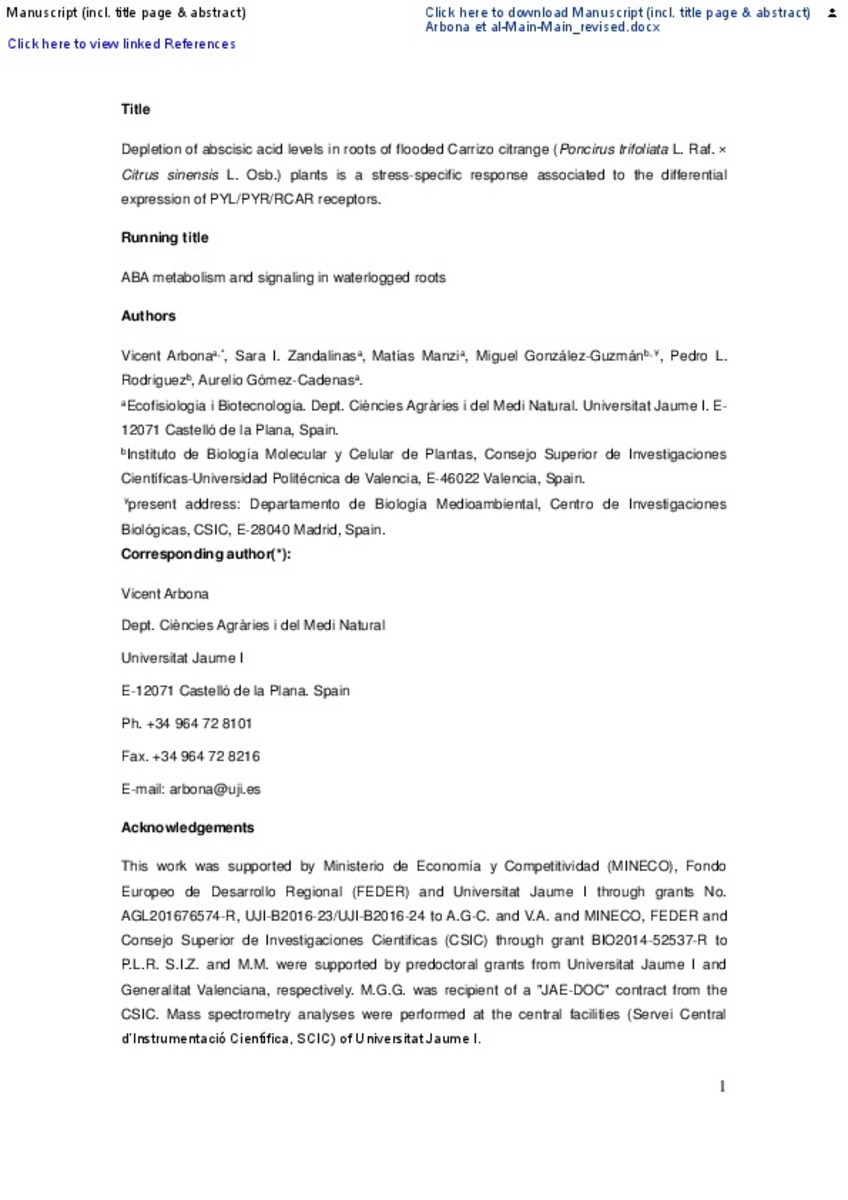Mostrar el registro sencillo del ítem
Depletion of abscisic acid levels in roots of flooded Carrizo citrange (Poncirus trifoliata L. Raf. x Citrus sinensis L. Osb.) plants is a stress-specific response associated to the differential expression of PYL/PYR/RCAR receptors
| dc.contributor.author | Arbona, Vicent | |
| dc.contributor.author | I Zandalinas, Sara | |
| dc.contributor.author | Manzi Fraga, Matías Jesús | |
| dc.contributor.author | González-Guzmán, Miguel | |
| dc.contributor.author | Rodríguez, Pedro L. | |
| dc.contributor.author | Gomez-Cadenas, Aurelio | |
| dc.date.accessioned | 2017-05-25T09:53:55Z | |
| dc.date.available | 2017-05-25T09:53:55Z | |
| dc.date.issued | 2017 | |
| dc.identifier.citation | Arbona, V., Zandalinas, S.I., Manzi, M. et al. Plant Mol Biol (2017) 93: 623. doi:10.1007/s11103-017-0587-7 | ca_CA |
| dc.identifier.issn | 0167-4412 | |
| dc.identifier.issn | 1573-5028 | |
| dc.identifier.uri | http://hdl.handle.net/10234/167647 | |
| dc.description.abstract | Soil flooding reduces root abscisic acid (ABA) levels in citrus, conversely to what happens under drought. Despite this reduction, microarray analyses suggested the existence of a residual ABA signaling in roots of flooded Carrizo citrange seedlings. The comparison of ABA metabolism and signaling in roots of flooded and water stressed plants of Carrizo citrange revealed that the hormone depletion was linked to the upregulation of CsAOG, involved in ABA glycosyl ester (ABAGE) synthesis, and to a moderate induction of catabolism (CsCYP707A, an ABA 8′-hydroxylase) and buildup of dehydrophaseic acid (DPA). Drought strongly induced both ABA biosynthesis and catabolism (CsNCED1, 9-cis-neoxanthin epoxycarotenoid dioxygenase 1, and CsCYP707A) rendering a significant hormone accumulation. In roots of flooded plants, restoration of control ABA levels after stress release was associated to the upregulation of CsBGLU18 (an ABA β-glycosidase) that cleaves ABAGE. Transcriptional profile of ABA receptor genes revealed a different induction in response to soil flooding (CsPYL5) or drought (CsPYL8). These two receptor genes along with CsPYL1 were cloned and expressed in a heterologous system. Recombinant CsPYL5 inhibited ΔNHAB1 activity in vitro at lower ABA concentrations than CsPYL8 or CsPYL1, suggesting its better performance under soil flooding conditions. Both stress conditions induced ABA-responsive genes CsABI5 and CsDREB2A similarly, suggesting the occurrence of ABA signaling in roots of flooded citrus seedlings. The impact of reduced ABA levels in flooded roots on CsPYL5 expression along with its higher hormone affinity reinforce the role of this ABA receptor under soil-flooding conditions and explain the expression of certain ABA-responsive genes. | ca_CA |
| dc.description.sponsorShip | This work was supported by Ministerio de Economía y Competitividad (MINECO), Fondo Europeo de Desarrollo Regional (FEDER) and Universitat Jaume I through grants No. AGL201676574-R, UJI-B2016-23/UJI-B2016-24 to A.G-C. and V.A. and MINECO, FEDER and Consejo Superior de Investigaciones Cientificas (CSIC) through grant BIO2014-52537-R to P.L.R. S.I.Z. and M.M. were supported by predoctoral grants from Universitat Jaume I and Generalitat Valenciana, respectively. M.G.G. was recipient of a “JAE-DOC” contract from the CSIC. | ca_CA |
| dc.format.extent | 37 p. | ca_CA |
| dc.format.mimetype | application/pdf | ca_CA |
| dc.language.iso | eng | ca_CA |
| dc.publisher | Springer Verlag | ca_CA |
| dc.relation.isPartOf | Plant Mol Biol (2017) 93:623–640 | ca_CA |
| dc.rights | © Springer Science+Business Media Dordrecht 2017. “The final publication is available at Springer via http://dx.doi.org/10.1007/s11103-017-0587-7" | ca_CA |
| dc.rights.uri | http://rightsstatements.org/vocab/InC/1.0/ | * |
| dc.subject | Abiotic stress | ca_CA |
| dc.subject | Drought | ca_CA |
| dc.subject | Flooding | ca_CA |
| dc.subject | Hormones | ca_CA |
| dc.subject | Photosynthesis | ca_CA |
| dc.subject | Signaling | ca_CA |
| dc.title | Depletion of abscisic acid levels in roots of flooded Carrizo citrange (Poncirus trifoliata L. Raf. x Citrus sinensis L. Osb.) plants is a stress-specific response associated to the differential expression of PYL/PYR/RCAR receptors | ca_CA |
| dc.type | info:eu-repo/semantics/article | ca_CA |
| dc.identifier.doi | http://dx.doi.org/10.1007/s11103-017-0587-7 | |
| dc.rights.accessRights | info:eu-repo/semantics/openAccess | ca_CA |
| dc.relation.publisherVersion | https://link.springer.com/article/10.1007/s11103-017-0587-7 | ca_CA |
Ficheros en el ítem
Este ítem aparece en la(s) siguiente(s) colección(ones)
-
CAMN_Articles [566]







